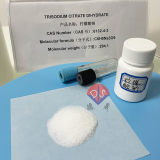Chinese VersionChina Suppliers > Hubei new DE sheng material science and technology co., LTD. > The characteristics and uses of sodium citrate
- Search Product
-
-
- Region :China/Hubei
- Tel : +86-18971041571
- Fax :
- Email :vickyzhao@whdschem.com
- URL :
- Add :Guanggu United Science and Technology City C8, Ezhou City, Hubei Province
- Details for The characteristics and uses of sodium citrate
-
The characteristics and uses of sodium citrate
Category : Other Chemicals/Others

CAS NO : 6132-4-3 EC NO : MF : MW : Specification : White Powder Packing : 500g/bottle Product description : Sodium citrate is currently the most important citrate salt, mainly produced by fermentation of starch substances to produce citric acid, which is then neutralized with alkaline substances. It has the following excellent properties: (1) Safe and non-toxic performance. Due to the fact that the raw material for preparing sodium citrate mainly comes from grains, it is absolutely safe and reliable, and will not pose a threat to human health. The Food and Agriculture Organization of the United Nations and the World Health Organization do not impose any restrictions on its daily intake, and it can be considered non-toxic. (2) Has biodegradability. After being diluted with a large amount of water in nature, sodium citrate partially becomes citric acid, and the two coexist in the same system. Citric acid is easily biodegradable in water through the action of oxygen, heat, light, bacteria, and microorganisms. Its decomposition pathway is generally through aconitic acid, itaconic acid, and citric anhydride, which are converted into carbon dioxide and water. (3) Has the ability to chelate metal ions. Sodium citrate has good chelating ability to metal ions such as Ca2+and Mg2+, and also has good chelating ability to other metal ions, such as Fe2+plasma. (4) Excellent solubility, and solubility increases with increasing water temperature. (5) Has good pH regulation and buffering performance. Sodium citrate is a weak acid and strong alkaline salt, which can form a strong pH buffer when combined with citric acid. Therefore, it has important uses in certain situations where pH is not suitable for large range changes. In addition, sodium citrate also has excellent retarding and stabilizing properties. The application of sodium citrate can be roughly divided into three categories: 1. Food application: Sodium citrate can be used in cool beverages to alleviate sourness and improve taste. Adding this product in brewing can promote saccharification, with a dosage of about 0.3%. In ice cream and ice cream manufacturing, sodium citrate can be used as an emulsifier and stabilizer, with a dosage of 0.2%~0.3%. This product can also be used as a preservative for dairy products, a viscosity enhancer for processed cheese and fish products, and a sweetener for food. Sodium citrate is non-toxic, has pH regulating properties, and good stability, making it suitable for use in the food industry. Sodium citrate is used as a food additive with the highest demand, mainly as a seasoning agent, buffer, emulsifier, expanding agent, stabilizer, and preservative; In addition, sodium citrate is used in combination with citric acid as a gelling agent, nutritional supplement, and flavoring agent for various jams, jellies, juices, beverages, cold drinks, dairy products, and pastries. 2. Medical applications: In the field of medicine, sodium citrate is also widely used. By utilizing the characteristic of forming soluble complexes between citrate ions and calcium ions, it can be used as an anticoagulant and transfusion agent for the preservation and processing of blood products. Sodium citrate is used as a preservative to preserve drugs such as syrup. Sodium citrate injection, like potassium salt, is used to correct the acidity of blood, body fluids, and urine as a diuretic, expectorant, etc. Sodium citrate can be used in combination with other reagents to extract and purify animal liver ribonucleic acid. 3. Chemical applications: Sodium citrate has the characteristics of good water solubility, excellent chelating ability for metal ions such as Ca2+and Mg2+in water, biodegradability, strong dispersion ability, and resistance to re deposition. Therefore, it is gradually becoming a substitute for sodium tripolyphosphate and is used to produce non biodegradable materials Uses : Blood collection additive Synonyms : no data
- more>>Other Products
-
- • Biological buffer 3- [N, N-di (hydroxyethyl) amino] -2-hydroxypropanesulfonic acid DIPSO
- • Luminol Sodium Salt
- • 4-Aminophthalhydrazide
- • acridinium ester DMAE-NHS
- • acridinium ester NSP-DMAE-NHS
- • Acridine hydrochloride NSP-SA
- • Acridine hydrochloride NSP-SA-NHS
- • NSP-SA-ADH
- • acridinium ester ME-DMAE-NHS TOOS; 3-(N-Ethyl-3-Methylanilino)-2-Hydroxypropanesulfonic Acid Sodium Salt
- • TOPS; Sodium 3-(N-Ethyl-3-Methylanilino)Propanesulfonate; N-Ethyl-N-Sulfopropyl-M-Toluidine Sodium Salt
- • ADOS Sodium 3-(Ethyl(3-Methoxyphenyl)Amino)-2-Hydroxypropane-1-Sulfonate Dihydrate
- • ADPS N-Ethyl-N-(3-Sulfopropyl)-3-Methoxyaniline Sodium Salt
- • ALPS N-Ethyl-N-(3-Sulfopropyl)Aniline Sodium Salt; Sodium 3-(Ethyl(Phenyl)Amino)Propane-1-Sulfonate; Sodium
- • DAOS; Sodium 3-((3,5-Dimethoxyphenyl)(Ethyl)Amino)-2-Hydroxypropane-1-Sulfonate
- • HDAOS; N-(2-Hydroxy-3-Sulfopropyl)-3,5-Dimethoxyaniline Sodium Salt
- • MADB N,N-Bis(4-Sulfobutyl)-3,5-Dimethylaniline Disodium Salt
- • MAOS N-Ethyl-N-(2-Hydroxy-3-Sulfopropyl)-3,5-Dimethylaniline Sodium Salt Monohydrate
- • DAB 3,3',4,4'-Biphenyltetramine Tetrahydrochloride